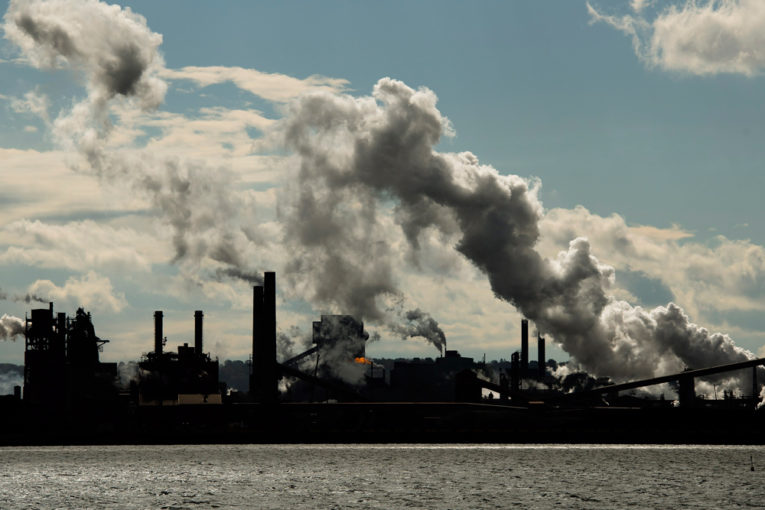
Justin Trudeau rolled out his national carbon tax — but left key questions unanswered for major industrial plants hit by the new measures.
The prime minister’s plan has two pillars: a tax on fuel, widely detailed Tuesday, and one on major industrial emitters. The tax on big emitters will kick in Jan. 1 but details are yet to come: the government hasn’t finalized its targets, said how much revenue it expects or how it’ll be spent.
The so-called output-based pricing system, or OBPS, that allows policymakers to reduce risks for high-emitting industries and those that are trade exposed will apply to large industrial emitters. Some regulations will be published in a week, while final regulations aren’t due until next year, and will apply retroactively to the start of the year. One way or another, the system will set a cap that will be a windfall for some firms, which could sell credits, and a tax for others.
“If you are the best in class, the idea is you don’t pay,” Canadian Environment Minister Catherine McKenna said in an interview Tuesday. “We want them to choose cleaner solutions, we want them to save money.”
The roll-out nonetheless leaves a key question mark hanging over Ontario, Canada’s most populous province, manufacturing heartland and financial hub. It comes as Canadian business groups issue widespread warnings about fading competitiveness, in the aftermath of U.S. tax cuts. The government’s upcoming fall mini-budget is expected to address competitiveness concerns.
Details Coming
Under OBPS, the government will set an emissions performance standard, relative to current emissions, that will vary by sector. The government has proposed a 90 per cent standard for four industries it considers at high competitive risk — cement, iron and steel manufacturing, lime, nitrogen fertilizers — and 80 per cent for other sectors, though it hasn’t finalized that.
Companies that keep emissions under their sector’s threshold won’t pay a carbon tax, and can even sell unused credits. Companies that exceed that threshold can buy credits or pay the tax, which will start at $20 per metric ton in 2019, rising to $50 per metric ton by 2022. The government hasn’t said what it will rake in from industrial emitters, but said proceeds won’t fund payments to individuals, as the fuel tax will.
Tracy Snoddon, a Wilfrid Laurier University associate professor of economics, wrote in a brief for the C.D. Howe Institute think-tank that the OBPS system helps ease competitiveness fears for certain companies, such as those that rely on trade or that are emissions-intensive.
“The outliers — the ones that are above average — they’re the ones that are going to be paying on their excess emissions,” she said in a telephone interview Tuesday. Snoddon tempered revenue expectations. “Those revenues are comparatively going to be low in the near-term, mostly because the credits are quite generous.”
‘Holes’ Remain
Trudeau’s plan fires a salvo into what is one of Canada’s top political battles right now — whether to have a carbon tax. It largely pits Trudeau’s Liberals, and other left-leaning parties, against the countries prominent conservatives, including federal Conservative Leader Andrew Scheer, who has criticized Trudeau for going easy on industrial emitters, and Ontario Premier Doug Ford, who is vowing to fight the plan.
“There’s still a lot of holes in it,” Ford’s environment minister, Rod Phillips, told BNN Bloomberg television on Tuesday. “We don’t want to see Ontario businesses punished, we don’t want to see Ontario families punished.” He said that major industrial emitters have a role to play as the province prepares its own climate plan.
“We have some very important industries, that have global competitive issues, and we need to work with them, but there is absolutely a role for them in terms of supporting our objectives around climate change,” he said.
Exporter ‘Fears’
McKenna said Canadians should ask what conservative lawmakers, who oppose the federal plan, would do instead. “We can’t have it be free to pollute. Under the Ford government, they think it should be free to pollute,” she said. She said the federal plan would not incorporate or honor any credits purchased under Ontario’s defunct cap-and-trade system.
The Canadian Manufacturers and Exporters industry group said the impact on Ontario could be substantial. The country already has a problem attracting investment and the carbon plan adds to that, president Dennis Darby said.
“For some manufacturers, it’s ‘this is our worst fear.’ For others, it’s just not clear,” he said. “We are actively engaged with the minister’s office in trying to make sure we’re able to do our best to influence this as best we can at this stage.”
Bloomberg.com
You can read more of the news on source
